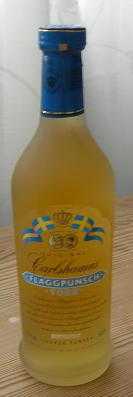Punsch

Punsch (also known as Arrack Punch, Caloric Punch or Punch) is a traditional liqueur in Sweden and to a lesser extent some other Nordic countries produced from arrack, neutral spirits, sugar, water, and various flavorings. Arrack, originally a strong Indian liquor, was imported from Java and became the base ingredient for making punsch. Punsch usually have 25% alcohol by volume (ABV) and 30% sugar.[1]
Etymology
Although they both refer to certain kinds of mixed beverages with liquor as a base ingredient, traditional Swedish Punsch is different from punch. Both names probably come from the same source: a Hindi loanword for five, referring to the traditional number of ingredients: alcohol, sugar, water, lemon/fruit and tea/spices.[1] The Swedish Historical Museum of Wines and Spirits (see below) states that it is more probable that the word came to Swedish via English, than as a direct loan from Hindi.[2]
History of Punsch in Sweden
The Swedish East India Company started to import arrack with the arrival of the ship Fredricus Rex Sueciae to Gothenburg in 1733. It quickly became popular, especially among the wealthy, who could afford the price of imported goods. Later it spread through all levels of society.[3]
A testament to the widespread popularity of punsch or rack (arrack)[4] is the songs of Swedish eighteenth century poet and composer Carl Michael Bellman. It is often mentioned in his three works Bacchi Tempel (1783), Fredmans Epistlar (1790) and Fredmans Sånger (1791) about a group of fictional characters, drunkards, bohemians and prostitutes in contemporary Stockholm. (See for example song no. 48 or epistle no. 41.)[5]
The high point of the Punsch consumption in Sweden came during the nineteenth century and focused on the students and teachers in the universities of Uppsala and Lund. Many traditional songs from that time are about the consumption of punsch or are meant to be sung during the collective festivities that were part of the cultural life in the universities' student associations at the time and still is.[2]
Sweden is basically the only country where this kind of punsch occurs.[6] It is usually called "the National Drink of Sweden". While the national drinks of other countries; French Cognac, Scotch whisky, Russian Vodka, etc. are made from local products, the Swedish Punsch is mainly made of imported ingredients.[3]
Hot or cold?
Early on, arrack was mixed with the other ingredients and heated, immediately before consuming it. Therefore it was served warm. From ca. 1840, when the drink's popularity was spreading, ready-mixed punsch was sold. From that time on, the habit of drinking it heated was gradually replaced by serving it chilled in the same way that Brännvin, Swedish vodka, is traditionally served. Especially during the winter, when served in combination with Swedish pea soup, it is still served hot.[2]
Common Nordic brands
- Carlshamns Flaggpunsch (founded by L.O. Smith)
- Cederlunds Caloric
- Facile Punsch
- Trosa Punsch
- Helmi Arrakkipunssi
Defunct Nordic brands
- Grönstedts Blå
- Bil-Punsch (Car Punsch)
- Hushålls-Punsch (Household Punsch)
- Kavalleri-Punsch (Cavalry Punsch)
- Sport-Punsch (Sports Punsch)
- Telefon-Punsch (Telephone Punsch)
- Lunda-punsch
See also
- Punch - a drink mixed with fruit
References
- ↑ 1.0 1.1 "Punsch". Nordiska Familjebok, Uggleupplagan via Project Runebergh (in Swedish) 22. Stockholm: Nordisk familjeboks förl. 1915. p. 609. Retrieved 7 August 2014.
- ↑ 2.0 2.1 2.2 "Punsch—Varm eller kall" [Punsch—Warm or cold]. http://spritmuseum.se/start/''. Spritmuseum. Retrieved 7 August 2014.
- ↑ 3.0 3.1 Rydberg, Inga. "Punsch och spelkort, Mera punsch" [Punsch and card, more punsch]. www.karlshamnsmuseum.se. Karlshamns Museum. Retrieved 7 August 2014.
- ↑ Bellman, Carl Michael. "N:o 9 Måltidssång" [No. 9 Meal song]. www.runeberg.org. Project Runeberg. Retrieved 7 August 2014.
- ↑ "Texter och musik" [Texts and lyrics]. www.bellman.net. Thord Lindé. Retrieved 7 August 2014.
- ↑ Salomonsson, Anders (1998). "Punsch". Populär Historia (6).
External links
- Punsch - at the Swedish Historical Museum of Wines and Spirits